Articulation #7 – Combinations
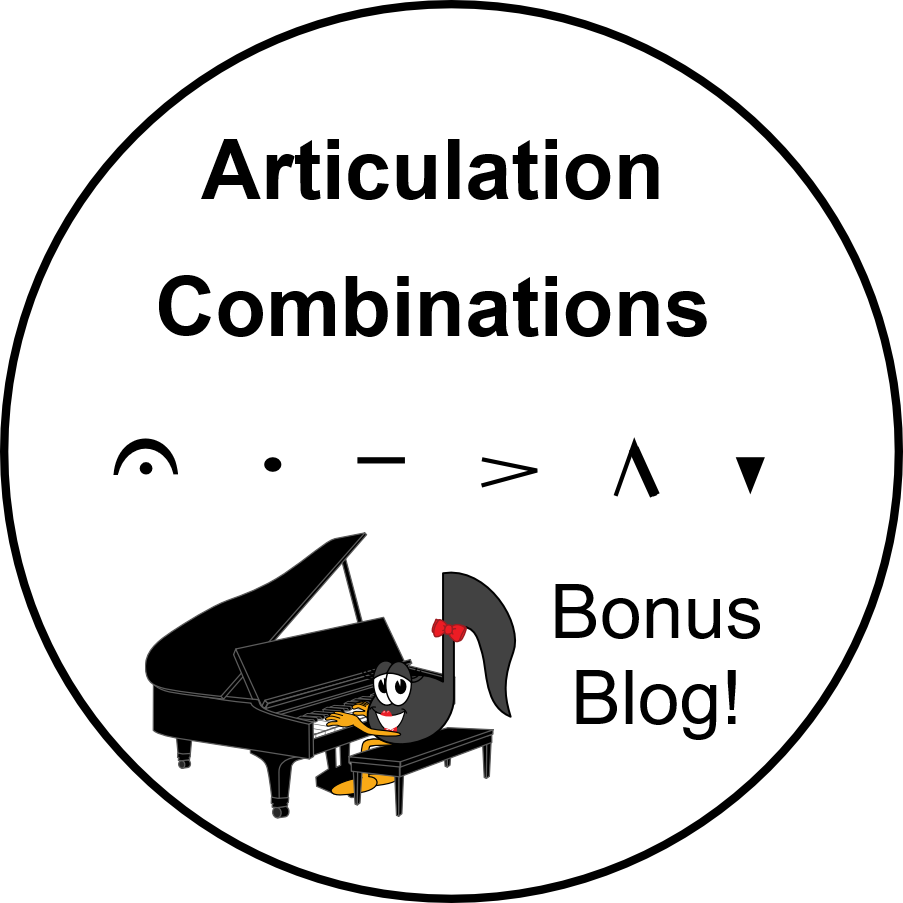
Articulation Signs tell us how to play a note. The Essential Dictionary of Music defines Articulation as "the manner in which notes are performed, such as staccato or legato".
In our Articulation Blog Series, we have explored:
- Articulation Blog Series #1 - Accent
- Articulation Blog Series #2 - Staccato
- Articulation Blog Series #3 - Staccatissimo
- Articulation Blog Series #4 - Marcato
- Articulation Blog Series #5 - Tenuto
- Articulation Blog Series #6 - Fermata
In this BONUS BLOG, we will explore how Articulations are Combined (two articulation sign combinations over or under one note, interval or chord).
Articulation Combinations are found in music from all genres!
Articulation Combinations - What Works and What Does Not Work
There are several different Articulation Combinations that "work" (sound appropriate together). In this blog, we will explore 5 Articulation Combinations:
- Tenuto and Staccato - Dimitri Kabalevsky's Early Morning Exercises, op. 3/86, no. 2
- Staccatissimo and Accent - William Bolcom's Old Adam Two-Step No. 1
- Staccato and Marcato - Claude Debussy's Golliwogg's Cake Walk
- Tenuto and Accent - Bela Bartok's Swineherd's Dance
- Accent and Fermata - Margaret Parsons' The Blacksmith of Bonnie Dundee
These Articulation Combinations work when put together because the purposes of the Articulation Signs can be performed together. For example, a Staccato + Accent works since you can play separated and stressed at the same time.
There are also different Articulation Combinations that do not work when put together. For example, a Staccato + Fermata or a Staccatissimo + Fermata would not be appropriate Articulation Combinations. Why? A Staccato Dot and a Staccatissimo Wedge tell us to play the note with a shorter duration and a Fermata indicates to hold the note for a longer duration. That is just a wee bit hard to play successfully!
Articulation Combinations = Staccato + Tenuto
The Staccato Dot and the Tenuto Mark are introduced in the Ultimate Music Theory Prep 1 Rudiments Workbook. At this level, they are usually not written in combination. When Transposition is added in the Ultimate Music Theory Basic Rudiments Workbook, we can see Articulations in combination.
Staccato = separated, detached. Tenuto = held, sustained (for the full value of the note).
Well, isn't this interesting! We CAN combine a "held" with a "separated"! The Dolmetsch Online Music Dictionary identifies that Legato (Tenuto Line) + Staccato = stressed and moderately short, separated from the next note.
Dimitri Kabalevsky's Early Morning Exercises, op. 3/86, no. 2 shows examples of the Tenuto + Staccato Articulation Combination. When I teach this Combination, I explain that the Tenuto Line smooths out the note and the Staccato Dot slightly detaches the sound from the next note that follows. I show them how to play with a "down - up" touch, like a half legato/half staccato combination (a "mezzo staccato" sound!).
Ti-Do Tips to Write a Staccato + Tenuto Articulation Combination:
- Write the Staccato Dot in the first empty space closest to the Notehead.
- Write the Tenuto Line in the first empty space above or below the Staccato Dot.
Remember, an EMPTY SPACE means that there is no part of any notehead or of the stem in the space. If the stem is going down on the left, the empty space is above the notehead/noteheads. If the stem is going up on the right, the empty space is below the notehead/noteheads.
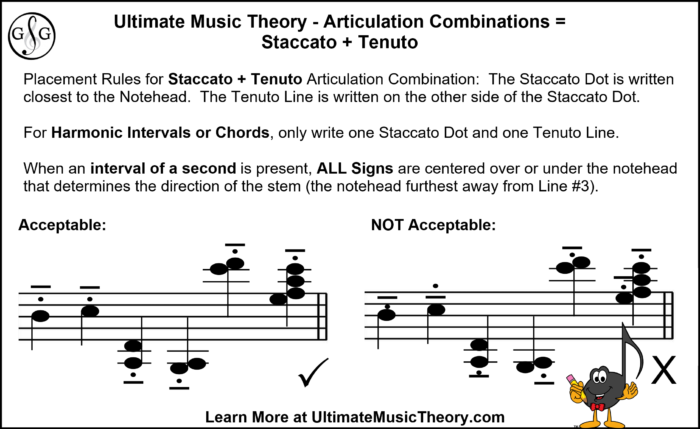
Let's play a game! Can you spot at least 1 Boo-Boo (placement mistake) in each of the 6 NOT Acceptable Staccato + Tenuto Articulation Combinations?
Here are the reasons:
- Not Acceptable Example #1: Staccato Dot is not in the first empty space above the notehead. (To Fix: move the Staccato Dot to Space #3 and the Tenuto Line to the space above the staff.)
- Not Acceptable Example #2: The Staccato Dot is not in the first empty space above the notehead. (To Fix: switch the placement of the Staccato Dot and the Tenuto Line.)
- Not Acceptable Example #3: The Staccato Dot cannot touch the Tenuto Line. (To Fix: move the Tenuto Line down a bit.)
- Not Acceptable Example #4: The Staccato + Tenuto Articulation Combination is written centered below the higher pitched note in the interval of a 2nd. (To Fix: move the Articulation Combination over so that it is centered below the lower pitched hugging note.)
- Not Acceptable Example #5: The Staccato + Tenuto Articulation Combination is written centered above the stem in the interval of a 2nd. (To Fix: move the Articulation Combination over so that it is centered above the higher pitched note in the interval of a 2nd. This is the note furthest away from the center line #3.)
- Not Acceptable Example #6: Only use one Staccato + Tenuto Articulation Combination, and center it above the note furthest away from line #3. (To Fix: remove the Articulation Combination that is written over the lowest note in the Chord Inversion.)
Articulation Combinations = Staccatissimo + Accent
The Staccatissimo Articulation is not included in the Ultimate Music Theory Series. However, I have included it in this Articulation Blog Series as it is an articulation that Senior Music Students will see in their music.
An example of a Staccatissimo + Accent Articulation Combination is found in the song "Old Adam Two-Step No. 1" written by William Bolcom.
Ti-Do Tips to Write a Staccato + Tenuto Articulation Combination:
- The Staccatissimo Wedge is written on a line an interval of a 4th either above or below the Notehead. The Wedge is always pointing towards the Notehead (so it is "flipped" when written below the Notehead, pointing upwards.)
- The Accent Sign is written in the first empty space either above or below the Staccatissimo Wedge. (Do you remember what the "first empty space" means?)
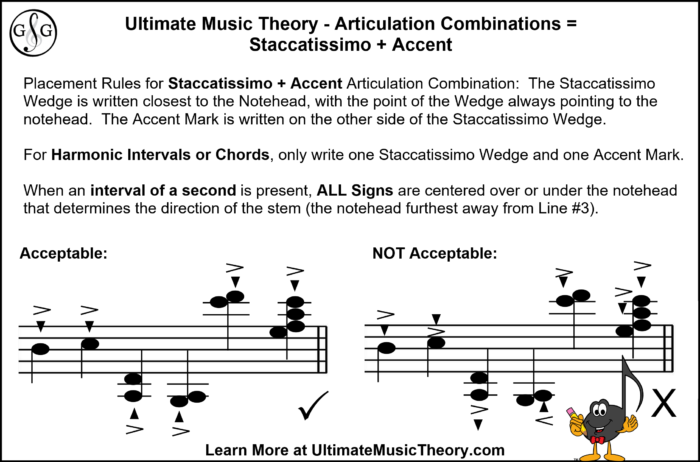
Did you notice that the placement of the Staccato Dot and the Staccatissimo Wedge are not the same? If you didn't, check out the Articulation Blogs Series!
Here are the reasons why the 6 NOT Acceptable examples are not acceptable:
- Not Acceptable Example #1: The Staccatissimo Wedge is written in Space #4. (To Fix, write it on Line #5, and then write the accent above it in the space above the Staff.)
- Not Acceptable Example #2: The Staccatissimo Wedge is not written closer to the Notehead, the Accent Sign is. Oops. (To Fix, write the Staccatissimo Wedge on Line #5, and then write the Accent above it in the space above the Staff.)
- Not Acceptable Example #3: Two boo-boos here. The Accent is written closest to the Notehead, and the Staccatissimo Wedge was not flipped so that the point of the wedge points towards the Notehead. (To Fix, write the Staccatissimo Wedge in the space below the ledger line and write the point of the wedge pointing towards the Notehead. Then, write the Accent Sign below the Staccatissimo Wedger.)
- Not Acceptable Example #4: First of all, this example is lined up centered with the Notehead closest to the Middle Line #3. (To Fix, center the Articulation Combination with the Notehead furthest away from the Center Line #3. This is the Notehead that determines the direction of the stem for the interval.) Secondly, did you notice that the Accent was written like a mini-crescendo? (To Fix, flip the Accent so that it looks like a mini-diminuendo.)
- Not Acceptable Example #5: This example is centered with the lower "hugging" note in the interval of the second AND the Staccatissimo Wedge is touching the Accent Sign. (To Fix, leave a space between the Staccatissimo Wedge and the Accent Sign, and move the Articulation Combination over so that it is centered above the upper note - the Notehead furthest away from the Center Line #3.)
- Not Acceptable Example #6: This example has two Articulation Combinations. (To Fix, we only need one Articulation Combination - centered above the top note of the Chord. So, erase that Articulation Combination that is centered over the lowest note of the Chord.)
Articulation Combinations = Staccato + Marcato
Claude Debussy's Golliwogg's Cake Walk has a number of Staccato and Marcato Articulation Combinations. When writing your Marcato Wedge, be consistent - either write it with the thicker/thinner line combination or write both lines "thin". (If you are not certain what I am talking about, read the Articulation Blog Series #4 - Marcato.)
Ti-Do Tips to Write a Staccato + Marcato Articulation Combination:
- The Staccato Dot is always written in the first empty space above or below the notehead.
- The Marcato "Wedge" is placed above the staff when the stem is pointing down, and below the staff when the stem is pointing up.
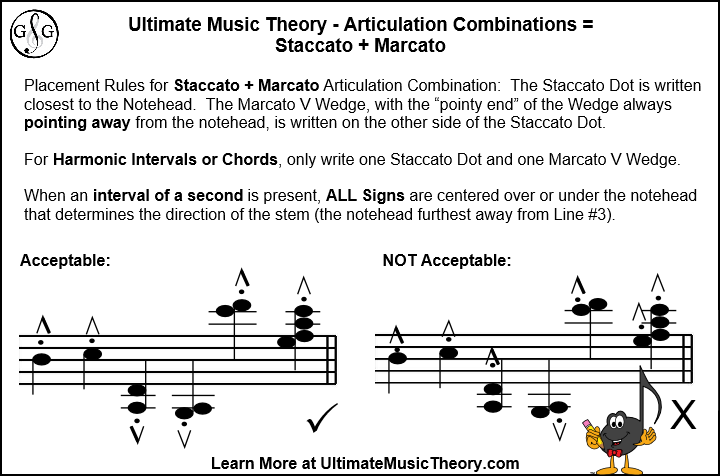
Did you notice that there are 2 correct ways to write the Marcato V Wedge? If you didn't, check out the Articulation Blogs Series #4 - Marcato!
Here are the reasons why the 6 NOT Acceptable examples are not acceptable:
- Not Acceptable Example #1: The Staccato Dot is not written in the first EMPTY space above the notehead, and the Marcato Wedge is not to be written on the Staff. (To Fix, write the Staccato Dot in Space #4 and the Marcato Wedge above the Staff.)
- Not Acceptable Example #2: The Staccato Dot is written inside the Marcato V Wedge (To Fix, place the Staccato Dot in the center of Space #4. Move the Marcato V Wedge to the empty space above the Staff.)
- Not Acceptable Example #3: The stem on the interval is pointing up, so the Articulation Combinations must be written below the notehead. (To Fix, write the Staccato Dot and the Marcato Wedge below the note.)
- Not Acceptable Example #4: The Articulation Combination must be centered under (below) the notehead for the note that determines the direction of the stem. It should be centered below the note in the space below the second Ledger Line. (To Fix, move the Articulation Combination so that it is centered below the lowest note of the interval.)
- Not Acceptable Example #5: The Articulation Combination must be centered over (above) the notehead in the space above the second Ledger Line as this note determines the direction of the stem. (To Fix, move the Articulation Combination so that it is centered above the highest note of the interval.)
- Not Acceptable Example #6: We only write the Articulation Combinations once. Even though the chord has one note on the left of the stem and three notes on the right of the stem, we only write the Articulation once. (To Fix, remove the Articulation Combination that is written over the lowest note of the Chord.)
Articulation Combinations = Tenuto + Accent
When a Tenuto Mark is used in conjunction with signs other than the Staccato Dot, the Tenuto Mark (the "line") is placed in the first empty space closest to the notehead.
The Accent Mark is usually written below the staff when the stem is pointing upwards, and above the staff when the stem is pointing downwards. For the exceptions to this rule, please read the Articulation Blog Series #1 - Accent.
An example of this Articulation Combination is found in Bela Bartok's Swineherd's Dance.
Ti-Do Tips to Write a Tenuto + Accent Articulation Combination:
- Write the Tenuto Line first, in the first empty space above or below the notehead.
- Write the Accent Mark in the first empty space above or below the Staff.
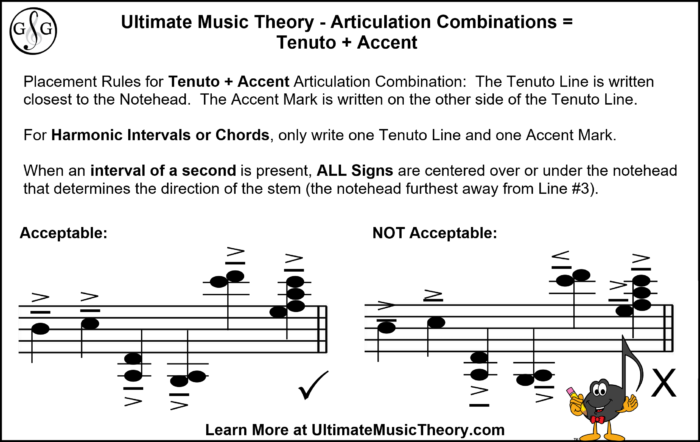
Here are the reasons why the 6 NOT Acceptable examples are not acceptable:
- Not Acceptable Example #1: The Tenuto Line is not in an empty space. The Accent Mark is written "on" Line #5. (To Fix: Write the Tenuto Line in the first empty space above the notehead - Space #4. Then write the Accent in the space above the Staff.)
- Not Acceptable Example #2: The Tenuto Line is not in the first empty space above the notehead. The Accent sign is touching the Tenuto Line. (To Fix: Write the Tenuto Line in Space #4, and write the Accent in the space above the Staff.)
- Not Acceptable Example #3: The Accent is written closer to the notehead. (To Fix: Write the Tenuto Line closest to the notehead. Write the Accent below the Tenuto Line.)
- Not Acceptable Example #4: For intervals of a Harmonic Second, Articulation Combinations are centered above or below the notehead that decides the direction of the stem. (To Fix: Move the Tenuto and Accent Combination so that it is centered below the Space Note.)
- Not Acceptable Example #5: The Accent Sign is written pointing in the incorrect direction and the Articulation Combination is written centered above the incorrect notehead. (To Fix: Flip the Accent Sign so that the wedge always points to the right. Move the Articulation Combination so that it is centered over the higher note, the space note.
- Not Acceptable Example #6: We only need to write one set of Articulation Signs when there is one stem! (To Fix: Remove the Articulation Combination on the left of the chord.)
Are you noticing a pattern here?
Articulation Combinations = Accent + Fermata
Margaret Parsons' The Blacksmith of Bonnie Dundee is a lovely little song with an Accent + Fermata Articulation Combination.
Ti-Do Tips to Write an Accent + Fermata Articulation Combination:
- The Accent Sign is always written in the first empty space above or below the staff. (Again, check out the exceptions in the Articulation Blog Series #1 - Accent.)
- The Fermata Sign is placed above the staff (and above the Accent when the accent is written above the note). For more details about the placement of the Fermata Sign, please read the Articulation Blog Series #6 - Fermata.)
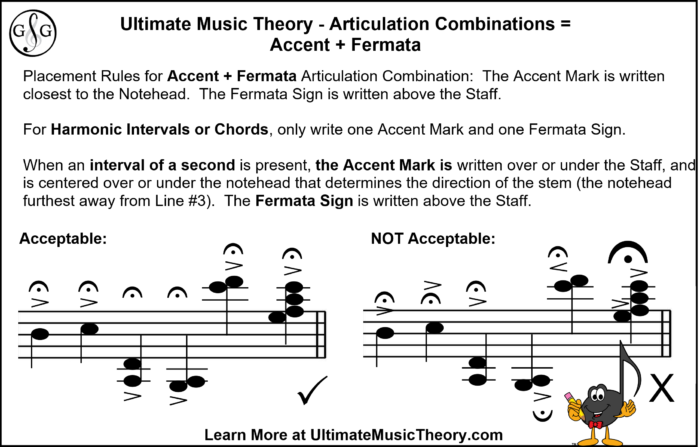
Here are the reasons why the 6 NOT Acceptable examples are not acceptable:
- Acceptable Example #1: The Accent is not in an empty space. The Accent Mark is written "on" Line #5. (To Fix: Write the Accent in the first empty space above the staff. Then write the Fermata above the Accent.)
- Not Acceptable Example #2: The Accent is written above the Fermata. (To Fix: Write the Accent above the staff, and then write the Fermata above the Accent.)
- Not Acceptable Example #3: The Accent is written above the Staff even though the stems are up. (To Fix: Write the Accent in the space below the Interval. Keep the Fermata above the staff, but move it closer to the top of the staff.)
- Not Acceptable Example #4: For intervals of a Harmonic Second, Articulation Combinations are centered above or below the notehead that decides the direction of the stem. This is also not an exception to the Fermata Placement Rules, so the Fermata sign should (To Fix: Move the Accent so that it is centered below the lowest note of the Interval. Move the Fermata above the staff.)
- Not Acceptable Example #5: The Accent Sign is written pointing in the incorrect direction and the Articulation Combination is written centered above the incorrect notehead. (To Fix: Flip the Accent Sign so that the wedge always points to the right. Move the Articulation Combination so that it is centered over the higher note, the space note.)
- Not Acceptable Example #6: We only need to write one Accent. And holy guacamole Batman, that Fermata Sign is HUGE! (To Fix: Remove the Accent on the left of the chord. Rewrite the Fermata so that it is the proper size.)
Articulation Blog Series - Thanks for Reading!
I hope that you have enjoyed my Blog Series on Articulation, and this review of Articulation Combinations. I know that I learned so much while researching these Blogs. This just proves my favorite quote: "You never know what you don't know until you realized that you didn't know it.". (As quoted by me!)
Have you checked out the Ultimate Music Theory Membership yet? I cannot tell you how many times I have accessed my Membership to save, print and send Fun Sheets to my Students, and to play the games. My Students love them!
Ultimate Music Teachers Membership
♪ LEARN ♪ PLAN ♪ TEACH ♪ GROW
The One & ONLY Ultimate Music Teachers Membership
To Become A UMT PRO!
Your Success Path Starts Here - Go To TeachUMT.com Today!
Keep on Learning... With a Smile and a Song!
Shelagh McKibbon-U'Ren


